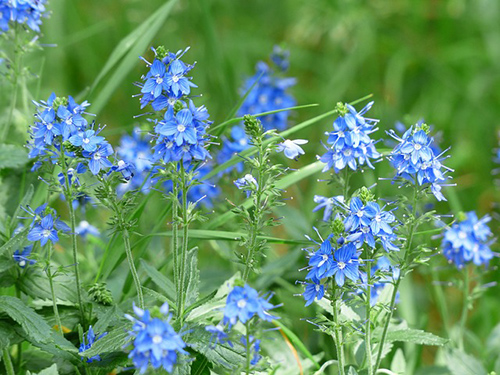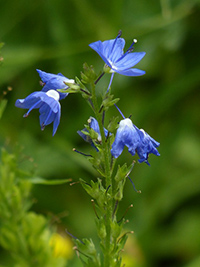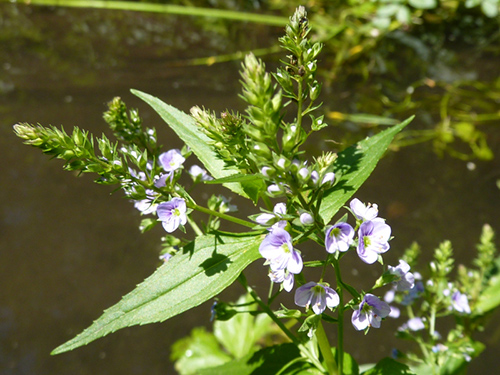Contents

In Northern European countries, a speedwell plant infusion substitutes for tea. It has natural, stimulating properties and lacks any undesirable effects.
Healing Properties and Indications
The speedwell plant contains tannin and a bitter substance (aucubosid), which give it astringent, refreshing, appetizer, and digestive properties; saponins and mineral salts, with expectorant, diuretic, and depurative properties; and resin, mannitol, and organic acids to which the plant probably owes its emollient properties on the skin. Its applications are as follows:
- Digestive afflictions: Lack of appetite, bloated stomach. Speedwell renders good results for migraines caused by lousy digestion.
- Respiratory afflictions: pharyngitis, catarrh, cough, bronchitis, and asthma (it prevents their crises). It also has antitussive and bechic (throat-soothing) properties.
- Diuretic, depurative, natural stimulant: The plant provides a sensation of well-being.
- Skin: Speedwell is used to wash eczema, to calm itching, to soothe cold-dried skin in cold climates, and as a cosmetic.
Speedwell Plant Scientific Facts

- Other names: Fluellin, groundhelle, gypsy weed, Low Speedwell, Paul’s Betony, Upland Speedwell, Veronica.
- French: Veronique, the d’Europe.
- Spanish: Veronica.
- Environment: It grows in silicate soils, forests, and meadows all over Europe, except for the Mediterranean regions. It also grows in cold areas of North and South America.
- Description: This is a vibrant, creeping plant of the Scrofulariaaceae family, growing up to 40 cm high. It has toothed, hairy leaves and pale blue flowers growing in terminal spikes. The plant has a soft aroma and a bitter flavor.
- Parts of the plant used medicinally: The whole plant.
How to use Speedwell

- Infusion with 30-40g of plant per liter of water. Drink three or four cups daily. When used as an appetizer, it must be drunk before meals.
- Fresh plant juice: Take two or three spoonfuls before each meal.
- Compresses are prepared with a decoction of 30-40g of plant per liter of water. Boil for ten minutes. Apply directly on the skin.
- Lotion with the decoction above.
Water Speedwell
Water Speedwell, also called water purple and brooklime, has healing properties similar to those of Veronica officinalis. Its fleshy leaves are used like watercress.
- Other names: Becky leaves, cow cress, Norse cress, well-grass, limewort, limpwort, well-ink, and water pimpernel.
DISCLAIMER: All content on this website is presented solely for educational and informational objectives. It would be best to not rely on the information provided as a replacement for advice, diagnosis, or treatment from a qualified medical expert. If you are pregnant, nursing, or have any preexisting medical concerns, you should talk to your doctor before using any herbal or natural medicines.
REFERENCES
- George D. Pamplona-Roger, M.D. “Encyclopedia of Medicinal Plants.” George D. Pamplona-Roger, M.D. Encyclopedia of Medicinal Plants. Ed. Francesc X. Gelabert. vols. 2 San Fernando de Henares: Editorial Safeliz, 2000. 475. Print. [speedwell plant]
- Nawrot-Hadzik, I., Granica, S., Domaradzki, K., Matkowski, A., & Badura, A. (2021). HPLC-MSn analysis, antioxidant and cytoprotective activities of Veronica officinalis L. herb extract from in vitro cultures. Industrial Crops and Products, 170, 113773.
- World Health Organization. (2005). WHO Monographs on Selected Medicinal Plants-Volume 3.
- Blumenthal, M., Goldberg, A., & Brinckmann, J. (2000). Herbal Medicine: Expanded Commission E Monographs. Integrative Medicine Communications.
- Natural Medicines Comprehensive Database. (2022). Speedwell. Retrieved from https://naturalmedicines.therapeuticresearch.com/databases/food,-herbs-supplements/professional.aspx?productid=1088
